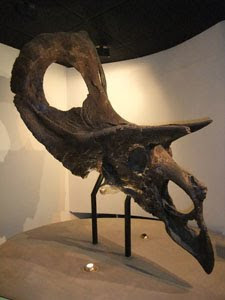I can tell you're shocked. Because you wouldn't know it, if all you had to go on was this article.
The short story is that it turns out that the skeletons we know as Triceratops were (probably) immature versions of a rather similar beast named Torosaurus. As Triceratops aged, the shape of their frills and horns changed, until they ended up looking like the animal we previously called Torosaurus. The two "different" dinosaurs are, in fact, the same thing - it's just that one is older.
The question is, if the two are the same animal, what do we call it? After all, you can't go around calling the same thing by two different names, at least not if you need to be scientifically precise. One of the two existing names has to be the official name, and the other must be "wrong" (or, at least, out-dated). But which is which? The gizmodo article linked above is quite clear about the answer: Triceratops never existed, and from now on we all have to call them "Torosaurus" instead. This is, to be blunt, utter bollocks.
Gizmodo got its story from an earlier version at boing-boing. You'll note that the writer of that piece has the honesty to say that he doesn't know which of the two names is now the correct one. The gizmodo writer obviously leapt to the conclusion that would give the most dramatic headline, and continued from there, without bothering to check further. This sort of thing is, sadly, not unusual in journalistic reporting of science stories.
The boing-boing writer may be honest, but he doesn't get off the hook, either. He got his story from a New Scientist article here, but he either didn't read it all, or didn't understand it. Because they got it 90% right: "Torosaurus will now be abolished as a species and specimens reassigned to Triceratops". The only bit wrong in that sentence is that Torosaurus is not, and never was, a species - it's a genus, or group of closely related species.
Tracing this tale of Chinese whispers even further, we find the original paper that sparked it all off, which is here. Okay, so you can't read the full article without putting up some money, but the title makes it all pretty obvious - and is the exact opposite of the gizmodo article. But "Torosaurus never existed, it was just an older version of Triceratops" sounds less sexy than what they came up with, and who cares about the facts? Even if I hadn't already known that it wasn't true (and, more importantly, why - which I'll get on to in a minute), it wouldn't have taken me more than a mouse click and a couple of minutes reading to find out.

So you can't believe everything you read on the internet. Who'd have thought, eh?
I suspect this 100% reversal of the story may have something to do with the fact that, superficially, it sounds plausible. If scientists can decide that Pluto is no longer a planet, why mightn't they decide that something else we're very familiar with isn't real either? Indeed, it wouldn't be the first time. The name Brontosaurus really did bite the dust, and those animals were re-assigned to the genus Apatosaurus, which is now the official name of the beasts we all used to call "brontosaurs". And, let's be honest, brontosaurs were well up there among the list of best-known dinosaurs, just as Triceratops is. Chances are, only Tyrannosaurus and Stegosaurus are likely to come close in terms of public familiarity.
Now, if your favourite dinosaur was, in fact, Torosaurus (fairly unlikely, I know), you are out of luck. That name has, as the New Scientist and JVP articles make clear, genuinely been given the boot. Or, at least, it will be if this study is properly confirmed and agreed to be correct - which, by the looks of things, it probably will be.
So, why is it that way round? It obviously isn't because of simple common sense, or Brontosaurus would still be with us.
The rules on how animals get their scientific names are laid down by the International Commission on Zoological Nomenclature. These include, among other things, a rule on what to do when two animals you previously thought were different turn out to be the same. And it's quite a simple rule: you pick whichever name is the oldest.
This can, it must be said, sometimes produce some odd results. Sometimes the older name turns out to be more obscure than the newer one. Presumably, you didn't find very many specimens of the animal you gave the older name to, or they just weren't very good specimens (which might explain why you didn't realise that the newer one was the same thing). This is, more or less, what happened to Brontosaurus.
But the first scientific description and naming of Triceratops was in 1889, a full two years before Torosaurus in 1891. As it happens, they were discovered by the same man - the famous American palaeontologist O.C. Marsh; but that's by-the-by, and its hardly surprising that he thought they were different. The point is that Triceratops is the older name, and it therefore has to be the one that's kept.
You wouldn't be allowed to have it the other way round even if you wanted to. Triceratops is real. Them's the rules.
(Top picture is of Triceratops, lower one is of Torosaurus. Both from Wikimedia Commons.)